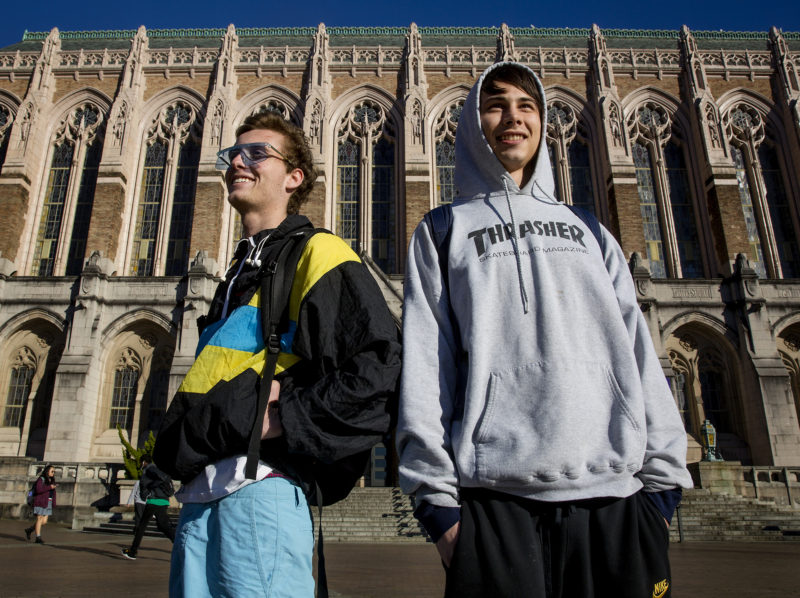
Noah Williams and James Poirier, both sophomores, already know it will take them longer than four years to graduate from the University of Washington — Williams because there wasn’t any room in courses required for his major, and Poirier because he has to take more language courses, even though he plans to major in biology.
SEATTLE — Noah Williams’ college education was behind schedule before he even stepped foot in a classroom.
By the time Williams arrived at the University of Washington as a freshman, all the courses he needed for his major in biochemistry were full, pushing him back by at least a quarter.
Instead of chemistry, calculus, physics or biology, he ended up with an introductory astronomy course, an elective in nutrition, and no chance of graduating in the four years he’d hoped it would take.
The courses “were interesting but weren’t relevant to what I’m going to pursue, so it set me back,” Williams, who is now a sophomore, said outside the university’s Suzzallo Library, a Collegiate Gothic-style landmark often likened to the Hogwarts School of the Harry Potter novels. “It’s just the little things” that can derail students, he said
In addition to time, delays like this cost money, raising the cost of tuition even higher than the mounting sums many families already expect to
Yet while 86 percent of incoming freshmen said in an annual national survey conducted by a research institute at UCLA that they were confident they’d graduate in four years, only 41 percent at public and 61 percent at private four-year universities actually do, according to the National Student Clearinghouse Research Center, which tracks this.
Now higher-education institutions including the University of Washington, or UW, are working to help their students graduate on time.
Partly they’re concerned about the students. But financial and political realities are also forcing colleges and universities to focus on this longstanding problem in new and aggressive ways.
Related: Colleges confront the simple math that keeps students from graduating on time
Students who stick around for more than four years, after all, use up dwindling state subsidies, financial aid and housing, and legislatures are increasingly tying public universities’ budgets to the proportion of their students who graduate on time.
“There’s lots of debate about what faculty do and what universities do, so we’re in the political spotlight,” said Ed Taylor, UW’s vice provost and dean of undergraduate academic affairs.
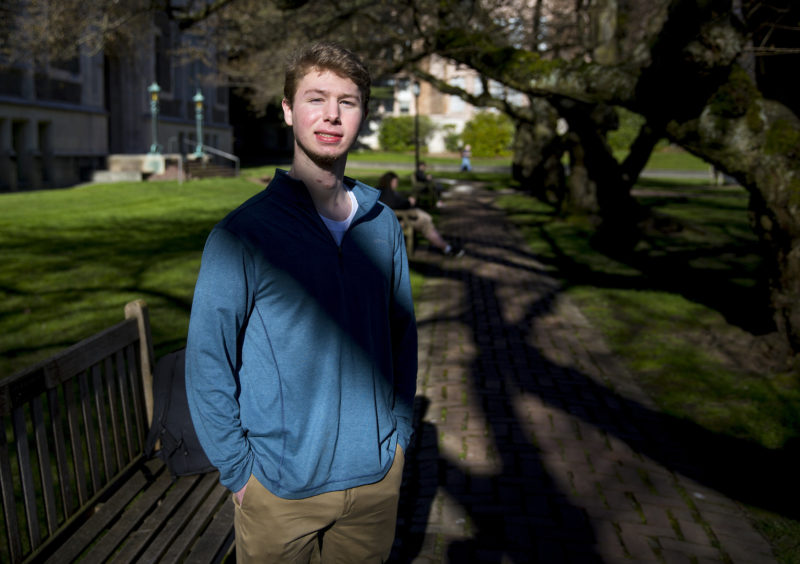
Brendon Fetsch, a student at the University of Washington, thinks such things as encouraging messages the university puts on its app are not particularly effective. “A lot of them were, like, ‘In order to be successful you should sign up for classes you can handle.’ Uh, yeah.”
The University of Texas at Austin, for example, promised to help more of its students finish in four years after then-Gov. Rick Perry complained publicly in 2012 that barely half were doing that, and that the rest were taking up seats and housing that could have accommodated another 1,000 freshmen per year. The university responded by promising that 70 percent of students would meet the four-year cutoff by 2016; it still hasn’t hit that target, graduating 66 percent last year, though it hopes to meet it this year.
“There is a big incentive for them to think of this in a different kind of way,” said Dhanfu Elston, vice president of Complete College America, which advocates for on-time graduation rates. “Institutions recognize that there’s a benefit to them. In the long run it’s going to save the institutions money, it’s going to save the students money, it’s going to save taxpayers money.”
Related: Worried about enrollment and judged on success, some colleges boost support
Other forces are driving this, too. “There’s greater pressure from students and their parents,” said Marisa Nickle, UW’s senior director of strategy and academic initiatives. “They’re shouldering more of the tuition … and there’s really a focus on return on investment.” Employers are also pushing. And students who finish in four years “become happy alumni, and you want that as well,” said Paul Francis, executive director of the Washington State Council of Presidents, which represents four-year public universities.
“We have a lot of processes at colleges and universities that are not geared toward the mindset and understanding of the students that they serve,” said Elston, who has worked at several higher-education institutions.

Piper Driskell is on track to graduate this spring from the University of Washington, but almost didn’t because she didn’t know she had to fill out a “graduation application.”
Piper Driskell, for example, is scheduled to receive her bachelor’s degree from UW on time, this spring. But she almost didn’t — because she didn’t know she had to fill out a “graduation application” up to three quarters before and no later than the third Friday of the quarter in which she planned to graduate.
“No one really tells you” that was a requirement, said Driskell, whose roommate fortuitously mentioned it. “It doesn’t need to be this complicated.”
Williams’ friend and fellow sophomore James Poirier will take longer than four years to finish because he didn’t take enough Spanish in high school to meet UW’s language requirement — even though he’s majoring in biology.
“There’s always reasons why you might not be right on your stuff from the beginning,” Poirier said. His family is helping him pay for college, so he isn’t feeling money pressure, he said. “But I want to go to grad school and I want to get going on that and it’s just more hoops I have to jump through.”
The new attention to helping students graduate on time benefits from the increasing availability of data that can help universities see, in real time, when people start to flounder — if their grades fall, for instance, threatening a scholarship, or if they’re not taking enough credits per semester.
“We can do outreach easier than 10 or 15 years ago, when we had to wait for a printout,” said Dan Feetham, UW’s director of undergraduate academic affairs advising.
Related: Many state flagship universities leave black and Latino students behind
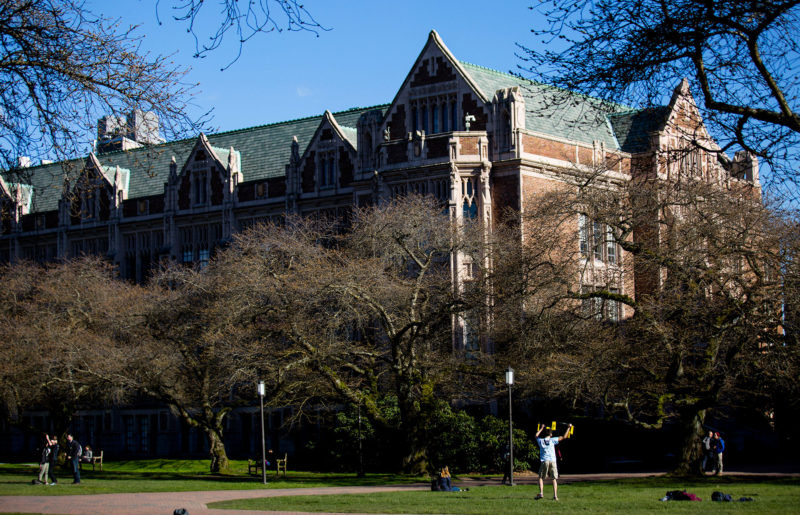
The University of Washington has improved its four-year graduation rate.
The university has also hired more advisors, assigned students to advisors even before they start as freshmen, expanded the capacity of high-demand courses by adding teaching assistants and putting lectures online, and given priority for those courses to students who need to take them for their majors.
To overcome the isolation it found some students felt on the flagship campus of nearly 46,000, UW also offers first-year seminars led by upperclassmen, tying together people with similar interests; that has improved the number of students who return after their freshman year by 3 percent, administrators say. It’s created a how-to video called U101 for incoming freshmen, which 87 percent said in a survey made them feel more connected to the university. And it sends encouraging messages over the “MyUW” app, reminding students about deadlines and providing coping tools for stress.
“We don’t have an easy-to-describe silver bullet” to solve this problem, Nickle said. “What we’re really doing is what I would call silver buckshot.”
This fusillade of measures has so far helped UW slowly raise its four-year graduation rate from 54 percent in 2005 to 66 percent last year, the university reports. Eighty percent of students graduate within five years and 83 percent within six. All are substantially above the national average for four-year public universities.
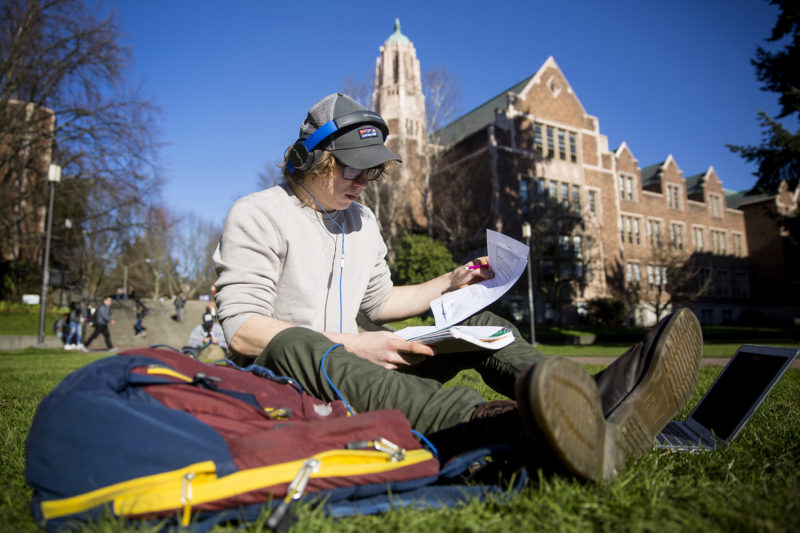
Michael Troksa, a mechanical engineering major at the University of Washington, thinks students are on their own when it comes to graduating on time. “When it comes down to it, it’s about keeping yourself on track,” he says.
That’s helped allow undergraduate enrollment to increase from 31,086 to 40,832 in the last 10 years, and boosted the number of bachelor’s degrees awarded from 8,306 to 10,626 last year, the university says. It’s also a more efficient use of the $342 million-a-year taxpayer subsidy, which as in other states has been steadily declining but still accounts for about 18 percent of what UW spends on instruction.
Related: Worker shortage spurs uncharacteristic partnerships connecting colleges, business
Other schools are also working on this problem. The University of North Carolina at Asheville is offering free summer courses to help students make up time if they’re short of the credits they need to graduate in four years, something fewer than 39 percent of them now do. Buffalo State and other public universities in New York will let students finish their degrees for free if it takes them longer than four years and they meet certain other criteria; only 30 percent of students who began at Buffalo State in 2012 — the most recent starting point for which the figure is available — graduated within four years.
Those remain very long odds. Even at universities like UW and the University of Texas at Austin that have been more successful at helping students finish in four years, around one out of three of them still don’t.
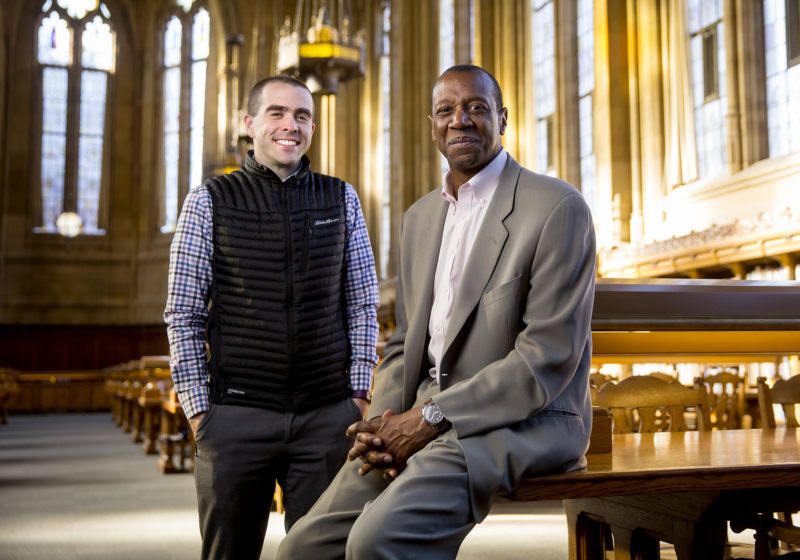
Ed Taylor, University of Washington vice provost and dean of undergraduate academic affairs, with Dan Feetham, director of undergraduate academic affairs advising, in the university’s Suzzallo Library. Both are involved in efforts to help students graduate in four years.
Part of that is on the students. Too few realize that if they don’t take 15 credits a semester at a four-year university, they can’t complete the 120 credits typically needed to finish on time, for instance.
In his previous jobs on campuses, said Elston, he would ask at freshman orientation how many students planned to take more than 12 credits per semester. Only about a tenth would raise their hands. Then he’d ask how many expected to graduate in four years “and every single hand went up.”
“No one had ever spelled it out for them” that taking only 12 credits meant they would be falling behind from Day One, Elston said. “When you come to college, you don’t know how to do college.”
Related: States connect students with degrees they don’t know they’ve earned
Yet most students say they depend on friends and other sources, not professional counselors, for information about staying on track, according to a Strada-Gallup Education Consumer Survey.
They also widely think that finishing in four years is up to them.

University of Washington freshman Jenica Tran says it’s mostly up to students to make sure they graduate on time. “You can get the help if you go out to seek it, but you have to do it on your own,” she says.
“Students have to take the initiative,” said Jenica Tran, a UW freshman who was relaxing on the quad. “You can get the help if you go out to seek it, but you have to do it on your own.” Another student, Brendon Fetsch, said such things as reminders on an app aren’t particularly effective. “I think they were pretty obvious. A lot of them were, like, ‘In order to be successful you should sign up for classes you can handle.’ Uh, yeah.” (The university concedes that just over half of students read the messages, and only about a third of those try the suggestions, so it’s trying to make them more visually appealing.)
“When it comes down to it, it’s about keeping yourself on track,” said Michael Troksa, a mechanical engineering major who works in the summers designing web pages to help him pay for college. “Usually the people who are going to be falling behind are the people who are switching majors or get here without knowing which direction they’re going.”
There are also cultural issues, and large bureaucracies that encumber universities themselves. At UW, administrators created what they called the “Academic and Student Affairs Alliance,” formalizing a common purpose between two arms of the university that might have been expected to already have one.
“Although it seems like a no-brainer, there’s not always alignment” between universities’ student affairs and academic functions, Elston said drily.

Marisa Nickle, senior director of strategy and academic initiatives at the University of Washington. “There’s really a focus on return on investment,” Nickle says.
For Nickle, there’s not a question that these two branches serve the same values or vision. “It’s, are people talking to colleagues three buildings over about what they’re doing? That’s the challenge at a large university, if you really want to make a large change.”
So is anticipating demand for certain subjects, and making sure there are enough seats available for required courses. “It’s hard to keep up with the pace and anticipate the pace,” said Taylor. “It’s tricky in a system where we’ve got tenured faculty, where we’ve got commitments to certain models.”
Still, he said, “There’s only so much capacity in residence halls, there’s only so much capacity in classrooms, there’s only so much capacity for advising” to continue letting students stick around for longer than they should.
Students also complain about being expected to be certain, as 18-year-old newly minted high school graduates exactly what they want to do for the rest of their lives.
“You have to come in your first quarter here really knowing what you want to do, and I don’t think that’s realistic,” Williams said. “There are a lot of pressures but there’s not a lot of time.”
This story was produced by The Hechinger Report, a nonprofit, independent news organization focused on inequality and innovation in education. Sign up here for our higher-education newsletter.